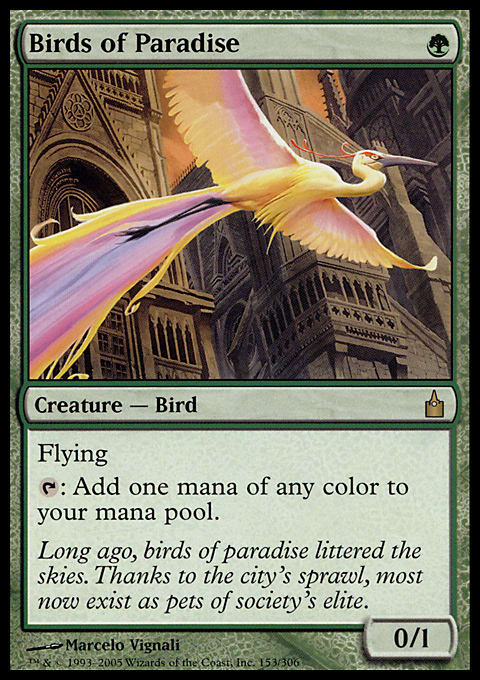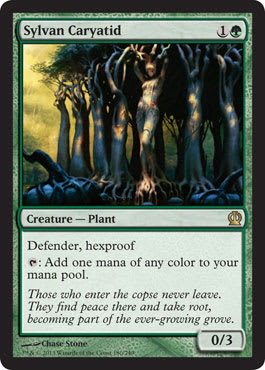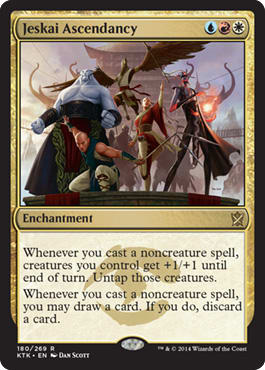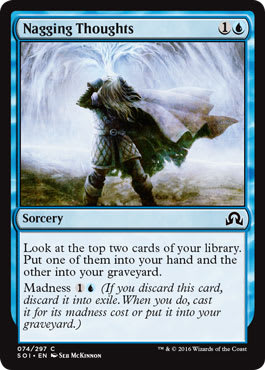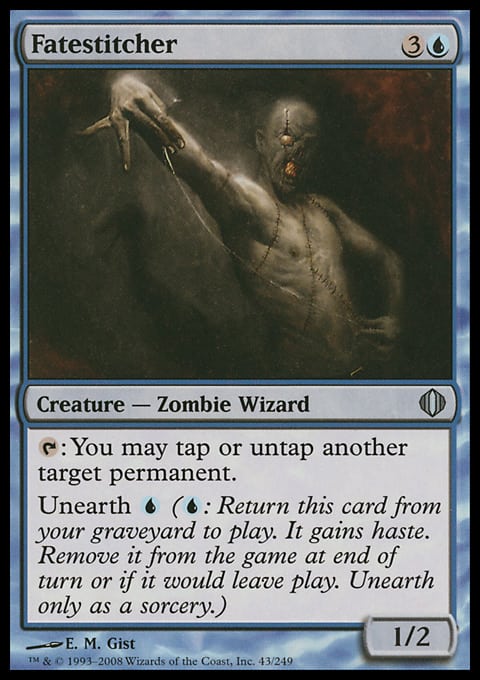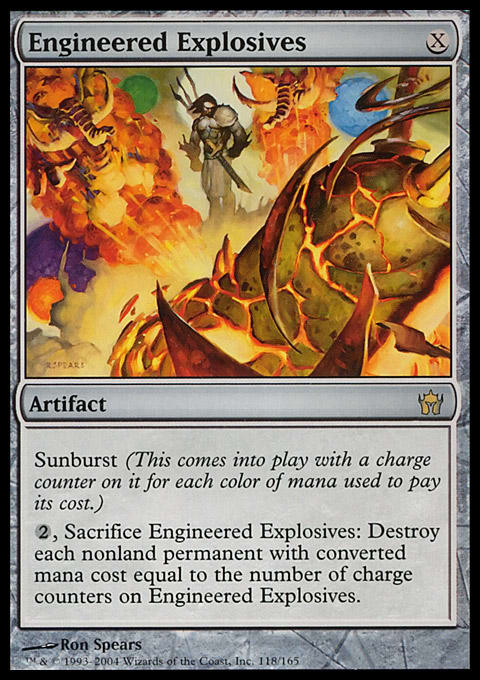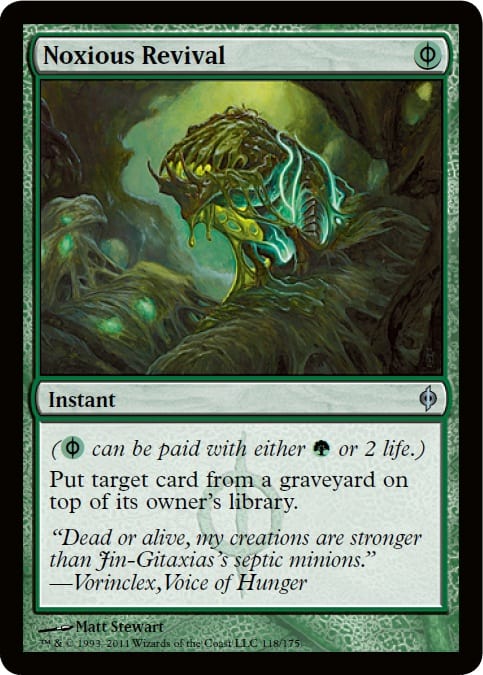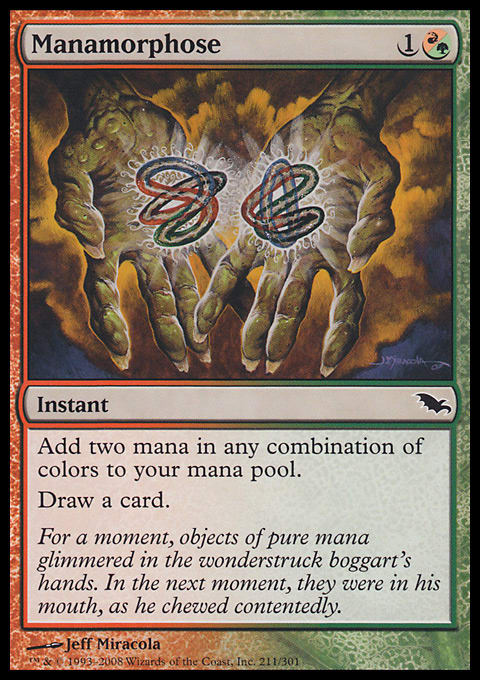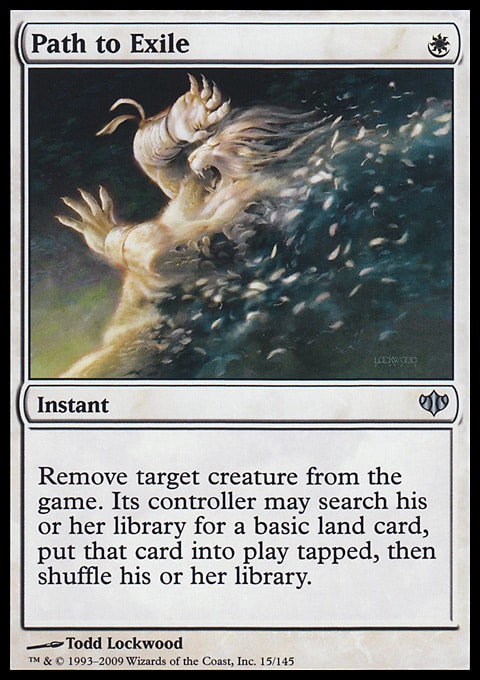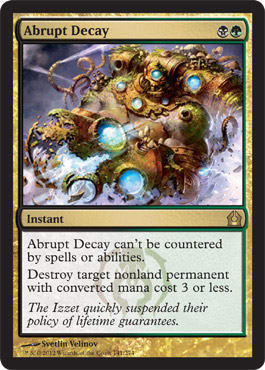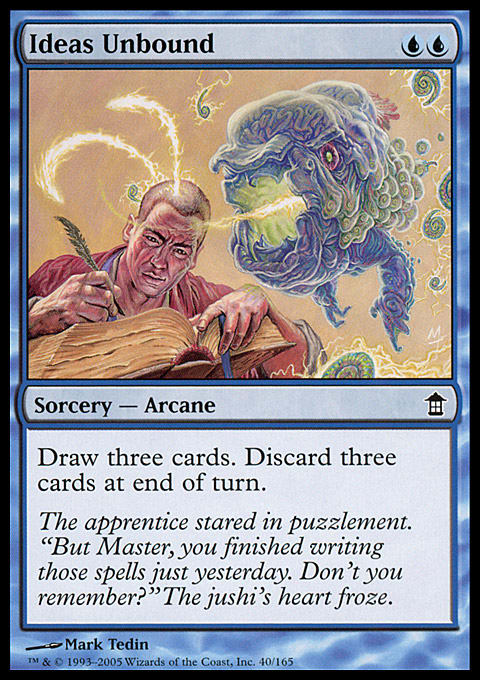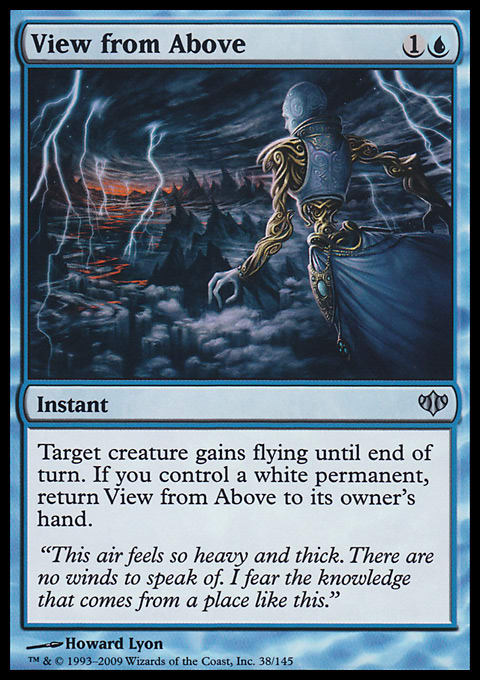Modern is a format that is all about finding a deck you enjoy and then playing a ton of it. Most recently, I've taken a shine to a deck that, while not tier 1, is something I have found a heck of a lot of fun to play: Jeskai Ascendancy Combo (or JAC for short). For those who are not familiar, JAC is something that I can best describe as "interesting storm". While it is a linear combo deck similar to storm, the way you end up winning the game each time you play it is going to vary.
Before we dive too much into the details, let's take a look at my current deck list:
Jeskai Ascendancy Combo -- Modern | Jeff Hoogland
- Creatures (12)
- 2 Fatestitcher
- 2 Noble Hierarch
- 4 Birds of Paradise
- 4 Sylvan Caryatid
- Instants (11)
- 1 Noxious Revival
- 1 Silence
- 2 Cerulean Wisps
- 3 Opt
- 4 Manamorphose
- Sorceries (14)
- 2 Nagging Thoughts
- 4 Glittering Wish
- 4 Serum Visions
- 4 Sleight of Hand
- Enchantments (5)
- 2 Abundant Growth
- 3 Jeskai Ascendancy
- Artifacts (2)
- 2 Engineered Explosives
- Lands (16)
- 1 Island
- 1 Botanical Sanctum
- 1 Breeding Pool
- 1 Hallowed Fountain
- 1 Steam Vents
- 1 Temple Garden
- 3 Flooded Strand
- 3 Misty Rainforest
- 4 Gemstone Mine
- Sideboard (15)
- 4 Leyline of Sanctity
- 1 Flesh // Blood
- 1 Jeskai Ascendancy
- 1 Scarscale Ritual
- 1 Wear // Tear
- 2 Path to Exile
- 3 Silence
- 2 Abrupt Decay
If you have not seen this deck before, it can be hard to pick out exactly how it wins the game. For those who are not familiar it generally involves one of these cards:
How do we kill with zero power creatures? Why in conjunction with our namesake of course:
Jeskai Ascendancy, in conjunction with creatures that tap for mana, allows us to chain through our deck with cheap cantrips. While we are drawing through our deck we also are making our mana creatures larger and larger to eventually deal lethal with. The more astute among you at this point will note that Sylvan Caryatid cannot attack for lethal. To work around this, we utilize one of my favorite toolbox cards in Modern:
In addition to being extra copies of Jeskai Ascendancy, Glittering Wish also allows us to deal lethal with a large creature outside of combat by fetching the card Flesh // Blood and using it with our giant creature. Glittering Wish can provide some additional utility mid-combo as well by fetching Scarscale Ritual to draw some extra cards or Wear // Tear to remove a problem permanent from play.
When you are comboing with this deck there are two resources you need to manage -- the cards you have in hand and the amount of mana you can produce. While Jeskai Ascendancy allow us to loot a bunch, it is important to remember that in general it does not actually draw us extra cards. Well, except when it does:
Nagging Thoughts is my favorite source of card advantage while we are comboing. Because it has madness, we are actually up a card when we loot away Nagging Thoughts. Past Nagging Thoughts, as mentioned above, Glittering Wish with Scarscale Ritual can also generate us some card advantage.
We manage the amount of mana we can produce while comboing in a few different ways. The easiest way is simply by having multiple mana creatures in play. While this sounds easy, it is often difficult to get multiple mana creatures into play and still combo as early as turn four. Because of this, we have a few different ways in our deck to generate extra mana. The best of these is a "mana creature" that can be put into play mid combo with haste:
The question I often get asked is -- why don't we play more copies of Fatestitcher? After all, I just said it is our best way to get additional mana mid combo. The answer to this is simple -- while Fatestitcher is really good mid combo, it is really terrible otherwise. Because we see so many cards while we are comboing, we can generally afford to only play two Stichers to allow us to minimize the number of times we draw them outside of comboing.
Outside of Fatestitcher, we have a few other ways of generating additional mana with just a single creature in play. First up we have a couple of cards that allow us to jump from zero mana to one mana:
These cards are actually how we can combo as early as the second turn with our best draws. Turn one mana dork, turn two Jeskai Ascendancy, followed up by one of these free spells to let us untap our creature to let us get comboing. These cards also provide us with various utility outside of generating a free mana mid combo. Engineered Explosives can buy us time against aggressive decks, or take problem permanents off of the table. Noxious Revival can rebuy our namesake after it has been countered / killed or even help us hit land drops in conjunction with a fetch land. The most important thing to remember about these cards midcombo is that they do not cantrip themselves. This means if you are short on cards, you want to avoid playing them out unless you have no other options.
Past our cards that jump us from zero to one mana, we also have some tools that allow us to go from one to two mana, as well as two to three mana:
Cerulean Wisps nets us a mana by untapping our creature with Ascendancy, then floating mana in response to the Wisps itself which untaps the creature for a second time. Manamorphose nets us one additional mana because it untaps our creature with Ascendancy and then makes two more mana when it resolves.
The rest of the cards in our deck are cantrips that help us draw through our deck while comboing, or find our missing pieces while we get set up. This is actually one of the reasons this deck is so consistent -- we have a good deal of cards to help us find exactly what we need:
A deck is more than just its main deck of course. While we already talked about some of the sideboard cards we have thanks to Glittering Wish, we have a few other cards we board in for specific matchups:
These cards are essentially different types of "anti-interaction" depending on what we are playing against. Silence allows us to Time Walk other fast combo decks as well as tell pesky control players to shush with their counter spells for a turn. Also relevant is that mid combo Silence is a card we can play with no targets to simply loot with Ascendancy if we need to.
Leyline of Sanctity is for Black based discard decks such as Jund and Mardu Pyromancer. Path to Exile and Abrupt Decay team up with our main deck Engineered Explosives to clear out problem permanents that try to lock us out of comboing.
In general, sideboarding is fairly straight forward with this deck. Most people are only attacking us with one of these three forms of disruption so we simply swap to whichever form of anti-interaction is most relevant.
For example against fast combo or control decks we board as such:
In:
- 3 Silence
Out:
Against combo decks, you will be rewarded for knowing how their deck functions because it allows you to maximize the timing of your Silence cast. For example, against Storm we can let them get all the way up until they cast Past in Flames most times. Against Ad Nauseum we want to wait till they cast their namesake most games.
Against Control decks we generally want to cast Silence the turn we are looking to resolve Jeskai Ascendancy and go off. In order to beat this, our opponent needs to leave up two or more pieces of interaction, which is often hard for them to do when while still applying pressure to us.
Against discard based disruption we make a similar swap only with Leyline:
In:
Out:
- 2 Engineered Explosives
- 1 Silence
- 1 Opt
The important thing to remember with this deck is that, unlike many combo decks that rely on Leyline for protection, we can actually cast ours if we draw them in the first few turns. While this does not protect form turn one discard, it can protect from further disruption while we reassemble a lethal combo turn.
Finally, against aggressive decks that play to the board, and may have permanent based disruption, we want to bring in our removal:
In:
Out:
- 1 Silence
- 1 Noxious Revival
- 1 Opt
- 1 Cerulean Wisps
The thing many new players often do wrong with a deck like JAC is over boarding. Remember we are a linear combo deck, so every card we cut related to our primary game plan comes at a real cost. This means, in general, you do not want to stray too far from the above board plans. You should never be boarding more than four cards unless you have a really good reason to.
An example of a really good reason to board more than four cards is against Burn. Burn is a deck that does not give us time to fumble around and has four copies of Eidolon of the Great Revel to directly punish us trying to cantrip into answers or Glittering Wish for them. Burn is the only deck in Modern I have played against with JAC where I break my four card boarding rule:
In:
Out:
- 1 Silence
- 1 Noxious Revival
- 2 Cerulean Wisps
- 2 Glittering Wish
- 3 Opt
We want to mulligan aggressively in this matchup for one of our eight enchantments. Leyline of Sanctity buys us a lot of time and Ascendancy lets us combo ASAP. Between Eidolon and the Burn deck's average clock, I think we simply do not have enough time to poke around with Glittering Wish in most games, so it gets trimmed. We want to leave a couple of Wishes so we can Wish for Flesh // Blood in order to kill with Sylvan Caryatid though.
If you are unsure exactly which anti-interaction plan you should be on for a given matchup, I tend to err on the side of more copies of Silence. Silence at its worst can prevent spot removal on our combo turn as well as simply Time Walk a good deal of other decks when we cast it during an opposing upkeep. Also, keep in mind that because we have access to Glittering Wish we have access to cards like Abrupt Decay even without directly boarding them in.
While I am very happy with my current configuration of the JAC deck, I think it is worth mentioning some cards that I am explicitly not playing that I have seen in other iterations of this archetype:
Faithless Looting comes up a lot while talking about this deck. While it is good at turning extra lands into potential spells, it is important to remember that this comes at a cost, a card. Unlike the one-mana Blue spells we play, Faithless Looting does not replace itself. Simply providing card selection in a deck that already has a way to loot consistently has diminishing returns in my experience.
Ideas Unbound is A+ when we are comboing, but fairly lackluster when we are not. I have tried it in ethe Nagging Thoughts slot before and was fairly unimpressed. When we are mid-combo, netting one card from Nagging Thoughts is generally more than enough. When we are not comboing, Nagging Thoughts replacing itself with a new card makes it better on average than Ideas Unbound which puts us down a card much like Faithless Looting.
The other cards people often try to play are various things that enable you to "go infinite":
All of these cards allow us to cast an infinite number of spells with the right number of mana creatures / Jeskai Ascendancies in play. In the case of Reborn Hope, we need two copies to loop together targeting each other. In my experience, none of these cards to allow us to go infinite are amazing in this archetype. While they will win you some games you could otherwise brick mid combo, they will cost you games in which you draw them before you are setup to combo because they do not do enough.
The only reason I would play an infinite combo in this archetype is if I was expecting my opponents to be gaining infinite life, because then I have a real need to get a large creature myself.
The main reason I have enjoyed playing this deck so much is because of how dynamic the game play tends to be. Even the most straight forward combo turns will often have small differences from game to game that require you to sequence things in different orders to maximize your chances of winning.
Budget Deck Lists
It is often noted on my stream that the core of this archetype is actually very cheap to build in terms of monetary investment. A lot of the cards it plays are either common or bulk rares. That being said, it does play a few format staples that can be expensive, so the following are my recommendations for how you can make the archetype cheaper to build while still being fairly competitive:
Budget JAC -- Modern | Jeff Hoogland
- Creatures (11)
- 3 Fatestitcher
- 4 Birds of Paradise
- 4 Sylvan Caryatid
- Instants (13)
- 2 Cerulean Wisps
- 2 Noxious Revival
- 2 Silence
- 3 Opt
- 4 Manamorphose
- Sorceries (14)
- 2 Nagging Thoughts
- 4 Glittering Wish
- 4 Serum Visions
- 4 Sleight of Hand
- Enchantments (5)
- 2 Abundant Growth
- 3 Jeskai Ascendancy
- Lands (17)
- 1 Island
- 1 Botanical Sanctum
- 1 Breeding Pool
- 1 Hallowed Fountain
- 1 Steam Vents
- 1 Temple Garden
- 3 Misty Rainforest
- 4 Flooded Strand
- 4 Gemstone Mine
- Sideboard (15)
- 4 Leyline of Sanctity
- 1 Flesh // Blood
- 1 Jeskai Ascendancy
- 1 Scarscale Ritual
- 1 Wear // Tear
- 2 Path to Exile
- 2 Silence
- 2 Abrupt Decay
- 1 Abrade
This build cuts the main deck copies of Noble Hierarch as well as Engineered Explosives. We go up a land and a Fatestitcher to make up for the Hierarch cut and we play an additional Silence and Noxious Revival over the Explosives.
Still not cheap enough? Here is the barest bones JAC list I think can be played without costing yourself too many percentage points:
Extremely Budget JAC -- Modern | Jeff Hoogland
- Creatures (11)
- 3 Fatestitcher
- 4 Birds of Paradise
- 4 Sylvan Caryatid
- Instants (12)
- 2 Cerulean Wisps
- 2 Noxious Revival
- 2 Opt
- 2 Silence
- 4 Manamorphose
- Sorceries (14)
- 2 Nagging Thoughts
- 4 Glittering Wish
- 4 Serum Visions
- 4 Sleight of Hand
- Enchantments (6)
- 3 Abundant Growth
- 3 Jeskai Ascendancy
- Lands (17)
- 2 Spirebluff Canal
- 3 Botanical Sanctum
- 4 City of Brass
- 4 Gemstone Mine
- 4 Mana Confluence
- Sideboard (15)
- 4 Young Pyromancer
- 1 Flesh // Blood
- 1 Jeskai Ascendancy
- 1 Scarscale Ritual
- 1 Wear // Tear
- 2 Path to Exile
- 2 Silence
- 2 Abrupt Decay
- 1 Abrade
In addition to cutting Explosives and Nobles, this build also replaces the Fetch / Shockland mana base with rainbow lands and trades the Leylines in the sideboard for copies of Young Pyromancer. To make up for the mana being slightly more shakey, I also added an additional copy of Abundant Growth to hopefully help smooth things out.
Wrapping Up
You can find countless hours of me streaming with various iterations of this archetype on YouTube at this point. If you are interested in learning the ins and outs of the archetype, watching me succeed (and fail on occasion) with the deck should give you a lot to learn from. In you have any questions about specifics that I did not cover above, please let me know in a comment below!
Finally before I finish today, I would like to share a board state that I found especially interesting in one of my games from the first paper event I played JAC at last weekend:
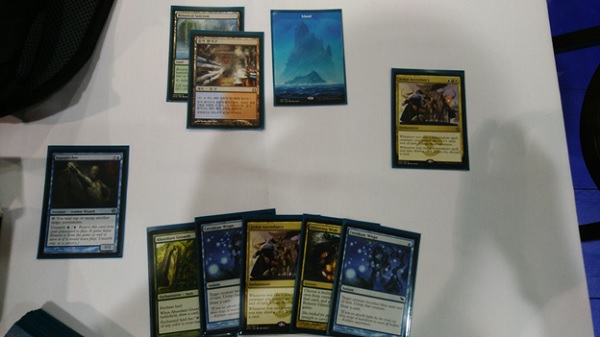
Context: We are 17 life. This is the start of our fourth turn. Fatestitcher is in our graveyard. The three lands and Jeskai Ascendancy are in play. The bottom five cards are our current hand.
Our opponent is playing ![]()
![]() Valakut and has six lands in play. On their previous turn, they cast Anger of the Gods to exile our Sylvan Caryatid. When they cast their spell they very obviously left their only Forest untapped.
Valakut and has six lands in play. On their previous turn, they cast Anger of the Gods to exile our Sylvan Caryatid. When they cast their spell they very obviously left their only Forest untapped.
What do you do? Why?
[showhide type="links1" more_text="What Happened:" less_text="Hide Text" hidden="yes"]
In my mind, when my opponent fumbled their lands around and ended up leaving up their basic Forest my mind jumped right to Nature's Claim. I felt I needed to make a move this turn because passing back to the Scapeshift deck when it was going to play out its seventh land while I had less than 18 life was dangerous.
If they did not have Nature's Claim, I was a strong favorite to win with the Fatestitcher, if they did have the Nature's Claim I had a chance to draw into a lethal turn still. In the event I bricked off, the four life from the Claim would put me out of range from dying to a seven land Scapeshift.
What ended up happening was my opponent had the Nature's Claim, but ended up messing up the timing of their spell a bit to give me the ability to win easily. Instead of responding to the Unearth trigger on my Stitcher, they instead responded to the first set of triggers when I cast Abundant Growth and responded to it with untapping a land.
Because my Stitcher was in play, I was able to respond to their Nature's Claim with not just one, but both copies of Cerulean Wisps that were in my hand. This let me draw some new cards and generate enough mana to easily cast my second Ascendancy to finishing comboing off.
Now, let's assume for a moment my opponent had sequenced slightly better. They instead respond to my Unearth trigger by killing my existing Ascendancy. This would make it harder for me to combo off this turn, but not impossible. Remember that even without an Ascendancy in play Cerulean Wisps is effectively a free cantrip with a mana creature out. This means my Wisps give me two chances to draw a white source to play out my second Ascendancy anyways and try to combo off. [/showhide]
















